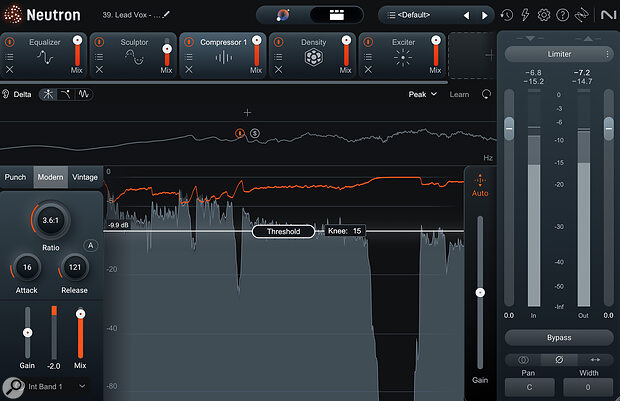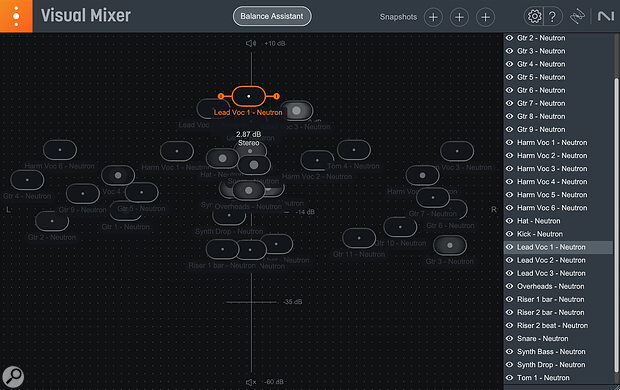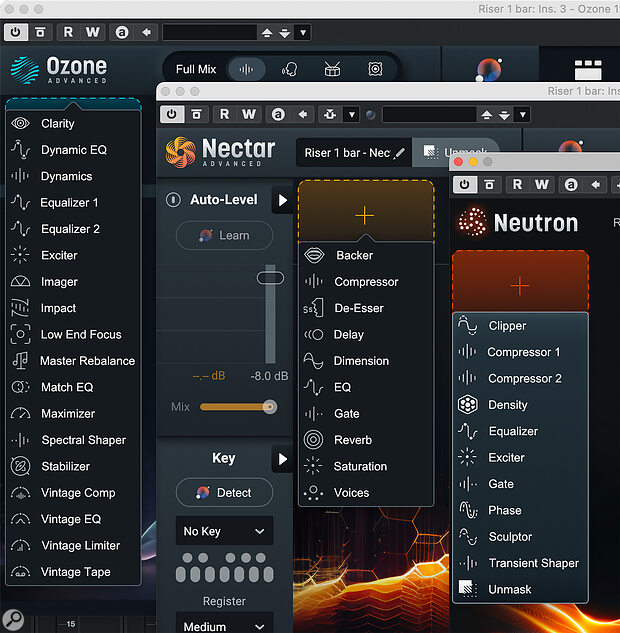 Neutron 5’s Mix Assistant can help you quickly find suitable processing options for individual instrument tracks within your mix.
Neutron 5’s Mix Assistant can help you quickly find suitable processing options for individual instrument tracks within your mix.
Can the improved, AI‑based Mix Assistant make iZotope’s already powerful collection of mixing plug‑ins more useful?
iZotope now offer several plug‑in ‘suites’, including the Ozone mastering suite and Nectar, which focuses on vocal production. The third is Neutron, which comprises a range of tools aimed at general mixing duties. In the recent iterations of all three suites, iZotope have introduced AI‑based ‘assistant’ features, which have the potential to help both those who are still learning the crafts of mixing and mastering, and those with more experience who perhaps need to be able to work more quickly. As well as allowing their individual processing modules to be loaded directly in your DAW, all three products offer a ‘mothership’ plug‑in that provides access to them all in one place. Ozone and Nectar were updated fairly recently (they were reviewed in SOS January 2024 and April 2024, respectively), and now it’s the turn of Neutron, which has been updated to version 5.
New ’Tron
Neutron 5 is available as the full version, or a streamlined Neutron Elements. The latter provides less experienced music producers/mixers with access to Neutron’s key processing elements, through the AI‑assisted Mix Assistant and a compact macro‑style control set. Inserted on a suitable track or bus, the Mix Assistant will audition the audio before offering processing suggestions that, hopefully, can improve the sound. The Mix Assistant is also available in the full version of Neutron, but here the user can choose to switch to a Detailed View, and dig much deeper into the control set of Neutron’s individual processing modules. The full version also includes a Visual Mixer plug‑in, designed to help with creating an initial static level balance of your various tracks (or buses). And, as with the top‑of‑the‑line versions of Ozone and Nectar, its component processors are also supplied as individual plug‑ins that can be used outside the mothership plug‑in.
With the AI genie now very much out of the bottle, it’s no surprise to see that the Mix Assistant features have been improved. From the user perspective, the most obvious demonstration of this is the revamping of the macro control set, which is now split across four panels called Tone, Dynamics, Saturation and Width. In their documentation, iZotope refer to these as Intent Controls, which is a good description: both the panel labels and the controls themselves now make their effect, if not the processes behind them, much clearer for the novice user.
 Neutron 5’s module selection includes three new options — Phase, Clipper and Density – and as shown here, all three can also be used as individual plug‑ins.
Neutron 5’s module selection includes three new options — Phase, Clipper and Density – and as shown here, all three can also be used as individual plug‑ins.
Once you move beyond the Mix Assistant’s Assistant View in the full version, the Detailed View includes three new modules: Clipper, Density and Phase. The previous line‑up remains, so you also have Equalizer, Compressor, Gate, Exciter, Transient Shaper, Sculptor (a ‘smart’ dynamic EQ to improve the tonal balance of instruments) and Unmask (to reduce unwanted frequency‑based competition between specific instruments). Taken as a whole, this suite provides plenty of options for a whole range of mix‑related processing tasks, but note that I said ‘processing’ — you won’t find effects such as reverb or delay here. As before, the Neutron 5 package also includes the very useful Tonal Balance Control 2 plug‑in.
Clipper’s purpose should be obvious from the name, and it’s a useful addition to Neutron’s complement of dynamics processors. Density is particularly interesting: it uses upwards compression to raise lower‑level parts of your audio signal, making it easy to prevent such elements disappearing in a busy mix. Finally, Phase attempts to fix any phase issues you might have within your audio, whether that’s asymmetrical waveforms on an individual track, or time‑based issues across multiple tracks, such as you might experience with multi‑mic drum recordings. Essentially, it automates what can be a complex task, and then lets you make manual adjustments if you feel some fine‑tuning is required.
All modules now offer a very useful ‘delta’ option — the delta signal is the difference between the dry and processed sound, so you can use this to hear exactly what a module’s current settings are adding or taking away. Finally, as in the latest version of Ozone, a number of Neutron’s modules offer both Mid‑Sides and transient‑sustain modes of operation alongside the normal stereo mode. For more experienced users, these alternatives might provide some interesting new processing possibilities.
 Once you switch to Detailed View you get full access to Neutron 5’s signal chain and, as shown here for the Compressor module, sophisticated control options within each processor.
Once you switch to Detailed View you get full access to Neutron 5’s signal chain and, as shown here for the Compressor module, sophisticated control options within each processor.
Neutron Workflows
The streamlined feature set of Neutron 5 Elements makes it very straightforward to use, but in the full version the user could settle on one of a number of potential workflows. First, as with Elements, you can employ the Mix Assistant on individual tracks or buses (or both) to offer initial advice on optimising those individual mix elements, before tweaking the Mix Assistant’s macro controls. But you could also use the Mix Assistant as a ’quick start’ option, and then use Detailed View to access the component modules that the Assistant added to the signal chain; as well as tweaking parameters, you can change the module order or add/subtract modules to suit your needs.
More experienced users might choose to bypass the mothership plug‑in entirely, and simply construct their own signal chains to process different tracks and buses from the individual component plug‑ins, just as you might with any other plug‑ins in your DAW. Even without the Mix Assistant, the plug‑ins are all very well featured, and they provide modern takes on both core (for example, EQ or compression) and more specialised (for example, spectral balancing, unmasking or phase management) mixing tasks.
iZotope’s Inter Plug‑in Communication technology... allows iZotope plug‑ins inserted on different DAW tracks to pass data to each other.
Finally, Neutron 5’s Visual Mixer plug‑in, which has its own dedicated Assistant, caters for a different aspect of the mixing process: level balancing and/or panning of your various tracks and buses. This is made possible by iZotope’s Inter Plug‑in Communication (IPC) technology that allows iZotope plug‑ins inserted on different DAW tracks to pass data to each other. It’s used in Neutron’s unmasking analysis/processing, naturally, but it’s also integral to the Visual Mixer and its ability to suggest appropriate mix levels for the various tracks/buses within a project. Again, it’s easy to see the appeal of this option for less experienced users.
Mix Fixer
Experimenting with each of these Neutron 5 workflows was an interesting experience for me. For example, applying the Mix Assistant to individual tracks is both easy and rapid, and in the vast majority of cases I was suitably impressed with Mix Assistant’s initial suggestions. The processing was, mostly, appropriately restrained, gently nudging each instrument in a suitable direction without overhyping anything, and I often found that the macro controls were more than adequate when I felt the results needed adjustment to deliver on my specific intentions for a given source’s role in the overall mix.
Perhaps unsurprisingly, I was generally happier with the Mix Assistant’s suggestions at the more granular track level (an individual guitar, drum, vocal, bass sound...) than when attempting the same thing at a group/bus level. For example, while Neutron processed individual drum elements such as snare or kick very sensibly, I felt that its suggestions for a drum bus were less successful and, on occasions, a little too aggressive. The plug‑in uses a relatively short analysis time prior to offering its processing suggestions, and I suspect that with a bus this window may not always be representative of the combination of instruments it contains, which can change through the length of a project. Having said that, though, even with just the macro controls I always found it pretty easy to rein things back in.
Clearly, if you were planning to use Neutron 5 on every track in a complex project, you would need to put in considerable configuration time, and there could be quite a load on your computer’s CPU, but used on a per‑instance basis it’s not particularly onerous in either respect. Finally, it’s worth noting that Neutron does introduce some latency. It’s designed for use while mixing, where this isn’t really an issue (your DAW will compensate for it automatically) but, should you need to record anything after you’ve started using it, it’s worth noting that the individual module plug‑ins do offer a zero‑latency option, albeit with some adjustments made to the processing.
Moving beyond the Mix Assistant into Detailed View rewards you with a significant step up in terms of the amount of control you’re given. Inevitably, since the individual processors are both so powerful and so fully featured, there is a learning curve to travel if you’re to capitalise fully on the potential offered here. Less experienced users may, at first, find this a little intimidating, but it’s a journey worth undertaking. Taking the Compressor as an example, this offers three compression styles (Punch, Modern and Vintage), up to three‑band operation (with each band featuring an independent set of threshold, ratio, attack, release and mix controls), as well as an overall mix control, internal or external side‑chain support, three different input level detection options (RMS, peak and true peak), real‑time visual feedback on the gain reduction, knee adjustment and automatic gain adjustment, and it can be used on mono, stereo or surround sound channels.
All three of the new components/plug‑ins allow a similar level of detailed control. For example, the Clipper also offers up to three‑band operation, and features a useful Learn function that can suggest appropriate band crossover frequencies. There are oversampling options for reducing artefacts, it provides clear visual feedback, and you can audition the delta signal, adjust the knee of the clipping process, and operate on the stereo, Mid, Sides and transient or sustain portions of a signal.
I found the new Density module particularly interesting. By boosting lower‑level parts of your signal — those that fall below the threshold setting — it reduces the overall dynamic range, without any impact on the high‑level parts of the signal, including transient peaks. It’s a great additional option to have and can help avoid some of the tedious manual volume automation that can be otherwise required to ensure that quieter sections of a track are not lost within the mix. Again, it is well specified with up to three bands available, delta monitoring and good visual feedback, stereo, Mid/Sides and transient/sustain modes, and control over the upward compression threshold, maximum applied gain, ratio and speed of attack. Upward compression can, in theory, raise any noise in the signal along with the wanted details, but it’s not something I noticed being a problem in this implementation, so I wonder if there is something clever happening behind the scenes to prevent that?
Balancing Act
What about Neutron’s other ‘assistant’ role in setting your overall mix balance? This option is built around the Visual Mixer plug‑in and IPC functionality mentioned earlier. It has been part of Neutron for several iterations, and Paul White described the process in some detail when reviewing Neutron 3 in SOS September 2019. In essence, the Visual Mixer offers two key features.
 For those new to the mixing process, the Visual Mixer provides a very appealing way to approach initial level and pan settings for the tracks within your mix.
For those new to the mixing process, the Visual Mixer provides a very appealing way to approach initial level and pan settings for the tracks within your mix.
First, after an ‘audition’ process, during which it analyses the signals on different tracks, it can create an initial static mix balance for your project. That could be helpful for even experienced mixers when faced with making sense of a big project quickly, but the concept will no doubt appeal even more to less experienced users. I’m not sure, though, that the current documentation (or the Neutron 5 learning resources on iZotope’s website) really makes the required workflow clear, in terms that such users would find particularly accessible. Yes, if you have a grasp of mixing console concepts you can probably work out a number of ways to approach the process. But if you know your way around a mix console already, then arguably you stand to benefit less from the Visual Mixer in the first place. More generally, iZotope are exceptionally good when it comes to the provision of online learning resources to support their products, so I’m sure this is something they could easily address with another ‘how to’ video or two.
Second, the main Visual Mixer allows you to adjust the level and pan of the individual elements in your mix manually, in the rather neat graphical display. This is a side of the Visual Mixer that I found very appealing, and I can certainly imagine those newer to the mixing process finding this a less intimidating starting point, while they’re still becoming familiar with the ins and outs of their DAW’s virtual mixing console.
 Neutron is available in bundles with iZotope’s Ozone and Nectar, and together they form a very impressive mixing and mastering toolkit.
Neutron is available in bundles with iZotope’s Ozone and Nectar, and together they form a very impressive mixing and mastering toolkit.
Is Neutron The Bomb?
Neutron 5 is definitely a worthwhile evolution of the Neutron concept. It has the potential to both improve the experience for novice mix engineers and offer useful processing options that should appeal to more experienced users. You could consider it simply as a very capable collection of sophisticated processors that you can use to do general mix processing, from tonal shaping to more surgical work on almost any element in your mix. With both routine tasks (EQ, compression, and so on) and more specialist ones (for example, spectral balance, upward compression, unmasking) catered for, there’s plenty to get your teeth into. The new processing additions (Clipper, Density and Phase) all bring something useful to the table in this context too, and judged on this basis alone, it’s perfectly possible to argue that the Neutron 5 suite offers good value for money.
Alternatively, Neutron 5’s Mix Assistant offers less experienced users access to the same powerful processing, but in a more user‑friendly fashion, and I found it genuinely impressive. As with Toontrack’s EZmix 3, it provides an accessible entry point to the often puzzling world of mix processing, and novices should be able to learn plenty from what the Assistant is attempting to do. If you find the detail of the full version intimidating, Neutron 5 Elements is a low‑cost option that can get you started, and there’s an upgrade path from that to the full version that you might consider as your confidence grows. The improvements to the Mix Assistant also make a strong case for existing Neutron users to upgrade to v5.
We can only really guess at where AI will eventually take ‘assisted mixing’. But today Nectar 5 is as clever, competent and accessible as it gets, while at the same time being deep, surgical and powerful — if you want it to be.
Pros
- A powerful suite of plug‑ins.
- Improved Mix Assistant is genuinely useful...
- But there’s plenty of control for those who want it.
- New Clipper, Density and Phase modules work well.
Cons
- Ambience or reverb treatments could be helpful.
- Visual Mixer workflows could be better explained.
Summary
Neutron 5 is a powerful suite of plug‑ins, but the refined Mix Assistant makes harnessing that power and potential incredibly quick and easy.
Information
Neutron 5 £239, Neutron 5 Elements £49. Also available in various iZotope bundles. Upgrade discounts available. Prices include VAT.
Neutron 5 $249, Neutron 5 Elements $49. Also available in various iZotope bundles. Upgrade discounts available.
